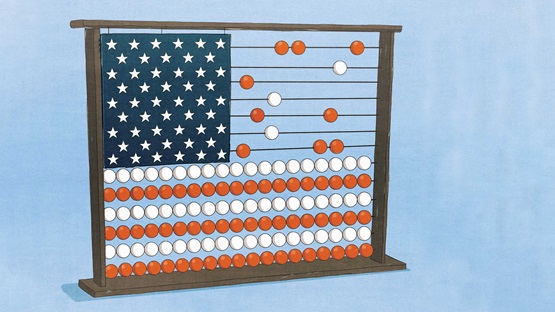Many Americans understand that inequality in earnings is much greater today than it was four decades ago. The patterns leading to this result are well documented for the U.S. as a whole: Pay for high-earning workers has advanced to even higher levels, and relatively steadily. Lower earners have seen less earnings growth, and the growth they have experienced has been uneven, with long periods of stagnation or even declines in real earnings.
But for many workers, the changes in earnings inequality that are most important to them are closer to home. These are changes experienced by the groups they identify with or the communities they live in. Understanding inequality for smaller demographic or geographic communities has been limited. This is in part because even researchers have had difficulty accessing data that could look at inequality within these groups. New data from the Income Distributions and Dynamics in America project allow us to examine how inequality has evolved within groups defined by state of residence and personal characteristics.
In this article, we examine how income evolved for earners with different racial and ethnic identities over the 15-year period leading up to the pandemic. We analyze data for Minnesota, but this analysis is easy to repeat for any U.S. state using the new Income Distributions and Dynamics in America data resource. We include information at the end of this article on how to recreate our analysis of relative earnings for other states.
Our analysis reveals that most groups were earning less than non-Hispanic White Minnesotans in 2019. This was true across much of the income distribution. Furthermore, income mobility for many groups—that is, the probability of moving up or down the income distribution—was among the lowest of any U.S. state. Mobility out of the lowest earnings levels was higher for Hispanic and Asian earners than for other demographic groups, while earnings growth for American Indian or Alaska Native workers lagged that of other groups.
Pre-pandemic trends in earnings gaps
The Income Distributions and Dynamics in America project is the result of a partnership between researchers at the Opportunity & Inclusive Growth Institute and the U.S. Census Bureau. It provides over 6 million statistics describing earnings levels and changes for a range of demographic groups at the state and federal levels. Income Distributions and Dynamics in America (IDDA) data cover 1998 to 2019, providing a detailed picture of earnings across U.S. communities up to the pandemic.
To make our analysis concrete, we define a few key concepts. The first is “relative earnings.” Relative earnings is simply earnings for workers of one group divided by earnings for a reference group. In this analysis, we compare with earnings for non-Hispanic White earners. The group of earners includes those who received a W-2 tax form from their employer in a given year. For example, in 2019 the relative earnings of Black workers in Minnesota was about 62 percent at the median, meaning Black workers earned 62 percent of what White Minnesotans earned.
A second concept is “group-percentile earnings.” This is the average earnings of individuals in a race and ethnicity group at a percentile of the group’s income distribution. For example, the 10th percentile of earnings for Black earners in Minnesota was $1,419 in 2005. This means that 10 percent of Black earners in Minnesota earned less than that in 2005, while 90 percent of Black earners earned more. The IDDA statistics report this information for several percentiles, all 50 states, and numerous age, gender, and race and ethnicity groups.
In our analysis, we study relative earnings growth for all race and ethnicity groups in the IDDA data in Minnesota. Figure 1 plots relative earnings at the 10th percentile over time for racial and ethnic identities in Minnesota. A dashed line at 50 percent indicates that income for a group is half of income for White earners. Another benchmark is 100 percent, which indicates that the incomes of the indicated group and non-Hispanic White earners are equal in that year.
The patterns in Figure 1 show wide disparities in earnings for low-income workers in Minnesota. The average earnings for Black and American Indian or Alaska Native workers at the 10th percentile of their group’s income distribution is less than half of their White counterparts. This is lower than the relative earnings of these groups nationally, where the 10th percentiles of Black and American Indian or Alaska Native earnings are about 60 percent of the 10th percentile of White earnings. Relative earnings for Black workers was increasing in Minnesota prior to the pandemic, closing the gap with White earners by 15 percentage points between 2012 and 2019, while the trend for American Indian or Alaska Native workers was flatter.
The earnings of Asian and White workers at the 10th percentile were roughly equal in 2005, but relative earnings for Asian workers rose to about 120 percent of White workers’ earnings by 2019. Group-percentile earnings is more volatile for earners who are Native Hawaiian or Pacific Islander than for other groups, because this is a small group in Minnesota, but it tends to track the relative earnings growth of Asian earners at this part of the income distribution. The 10th percentile of income for Hispanic earners hovered around 75 percent of White income.
Figure 2 repeats this analysis for high earners, the top 2 percentiles. The Income Distributions and Dynamics in America data are especially useful for understanding earnings in this group, as high earners tend to underreport income on surveys and may not be well represented in smaller datasets. In the top 2 percentiles, Asian earners still experienced relative earnings growth, though the pattern is not as pronounced as for low earners in Figure 1. Relative earnings gaps have widened since 2009 for the top 2 percentiles of Black, Hispanic, and American Indian or Alaska Native workers in Minnesota. Unlike in Figure 1, income for top Native Hawaiian or Pacific Islander earners fell below 75 percent of income for top White earners.
We can repeat this analysis for earners at different points of the income distribution between the 10th and 98th percentiles. When we do this, we see that relative earnings at the 50th and 75th percentiles are more tightly clustered between 50 and 100 percent of non-Hispanic White incomes than they are at other percentiles. The relative earnings growth experienced by low-income Black workers persists at the 25th percentile but flattens out above it. In general, relative earnings gaps appear stable for intermediate earners.
Putting together these pieces, the overall picture for Minnesota shows:
- For earners below the median in their group, relative earnings grew for earners who are Asian and Native Hawaiian or Pacific Islander. Black earners were making inroads in lower-income percentiles prior to the pandemic.
- At the median, earnings gaps in 2019 are similar to what they were in 2005.
- At the highest earning levels, Asian earners recently closed the gap with non-Hispanic White earners. The relative earnings gap is widening for Black, Hispanic, and American Indian or Alaska Native earners.
Where did earnings growth stand for groups in 2019?
Another way to understand how earnings have grown differently for Minnesotans with different racial and ethnic identities is to track individual earners over time. In addition to the static statistics used above, the IDDA data contain information on how income changed for individual earners over time aggregated to group levels. These data let us ask, Do the demographic groups with wider earnings gaps see higher levels of mobility? Or are they more likely to remain in lower-income brackets, entrenching inequality?
Figure 3 answers these questions in Minnesota for the five years ending in 2019. The green bars on the left show the probability that earners who start in the bottom quartile (25 percent) of the income distribution in 2014 remain there in 2019, rather than moving up to a higher-income bracket. Lower rates of persistence at the bottom of the income distribution suggest that a group has greater opportunity for earnings growth, though some individuals may leave the lowest quartile because they do not receive a W-2 in 2019. The yellow bars on the right show the same persistence probability for earners who start in the top quartile. Looking at persistence at the top gives a sense of how secure high income is for workers with different racial and ethnic identities. The whisker bars show the range of persistence values across all 50 states for comparison.
In general, high earners of all groups are likely to remain high earners while low earners move out of the lowest earnings quartile more often than not. The yellow bars are much higher than the green bars, indicating that persistence in the highest earnings quartile is much greater than persistence in the lowest earnings quartile, and the green bars are below 50 percent, indicating that less than half of the lowest quartile earners are still there five years later. It’s less common for earners in the top quartile to move out of the tax data, leaving employment entirely, so higher values for persistence at the top indicate that earners were less likely to move into lower earnings quartiles. Some of the lower persistence of low earnings is due to movement up into higher earnings quartiles, but some reflects movement into nonemployment.
Another feature of income in Minnesota is that it tends to show more persistence across groups at all income levels compared with other states (the green and yellow bars in Figure 3 tend to fall toward the high end of the 50-state ranges). This is particularly true for high-earning Asian, Black, and White Minnesotans and for low-earning Hispanic, Black, White, and Native Hawaiian or Pacific Islander Minnesotans. This means both high and low earners in Minnesota are more likely to stay at their earnings level over five years than their counterparts in other states.
Turning to specific groups, there are meaningful differences in income mobility. Asian earners were about 10 percentage points more likely to stay in the top quartile over the five-year horizon than other groups of earners in Minnesota. Just over 30 percent of earners who identified as White, Hispanic, or Native Hawaiian or Pacific Islander who started in the lowest earnings bracket remained there in 2019. Black and American Indian or Alaska Native earners had the highest rates of persistence in the lowest quartile of earnings, though here, the differences were smaller and transitions out of employment are an important part of the story.2
To put these numbers in perspective, in 2014, the bottom quartile of earners in Minnesota made less than $12,940, and the top quartile made more than $57,290. Figure 3 shows that when we look at the same starting point—the group of all workers with earnings less than $12,940—workers face different prospects of earnings growth across race and ethnicity groups. In other words, the disparities highlighted in the first section reflect both different starting points and unequal opportunities to get ahead.
Overall, the mobility data provide some contours to the picture of inequality given by the relative earnings analysis. In 2019, Asian earners saw relative earnings growth at the bottom and top of the income distribution, which is why they have greater persistence in high-income percentiles and greater movement out of low-income percentiles than White earners. For American Indian or Alaska Native earners, the pattern is reversed, with more persistence in low-income brackets and more movement down from high-income brackets. And while Black and Hispanic Minnesotans face income disparities at every percentile, as described earlier, their rates of upward and downward mobility are similar to those of White workers over the 2014 to 2019 period.
The big picture on earnings inequality and growth for race and ethnicity groups
Taking stock of income inequality in Minnesota, we find large earnings disparities at the state level and persistent gaps by race and ethnicity. The lowest-income White earners in Minnesota take home nearly double the earnings of the lowest-income American Indian or Alaska Native and Black earners, and they are advantaged at the highest income levels as well. Asian workers have shown high relative earnings growth. At the same time, some groups with large earnings gaps had relatively high rates of upward mobility. Persistent earnings gaps may be related to comparatively low levels of income mobility for most groups in Minnesota.
Conversations on income inequality have been prominent over the COVID-19 pandemic and recession, but it’s not always clear how national trends translate to local economic landscapes and the different people who live there. New data from the project provides the granularity needed to zoom in on any state—in this case, Minnesota—and analyze relative earnings and earnings mobility for detailed demographic and earnings groups.
Endnotes
1 We used this approach in order to compare groups for whom persistent earnings gaps have been demonstrated over time. An alternative would be to use a state or national average as the reference or to use another race, ethnic or gender group as the comparison. It is possible for users to construct alternative comparisons using the IDDA data. In this article, the race and ethnicity groups we consider are Hispanic, non-Hispanic American Indian or Alaska Native, non-Hispanic Asian, non-Hispanic Black, non-Hispanic Native Hawaiian or Pacific Islander, and non-Hispanic White. We occasionally omit “non-Hispanic” in the text for brevity.
2 Low-income Black workers were slightly less likely to move out of employment from 2014 to 2019 than White workers—21 percent versus 25 percent. Yet, more than 30 percent of American Indian or Alaska Native workers who started in the bottom quartile did not receive a W-2 in 2019, suggesting a more tenuous foothold in the labor market. In general, transitions from the bottom quartile out of the W-2 data were less common in Minnesota than in other states.
Abigail Wozniak is vice president and director of the Bank’s Opportunity & Inclusive Growth Institute.







